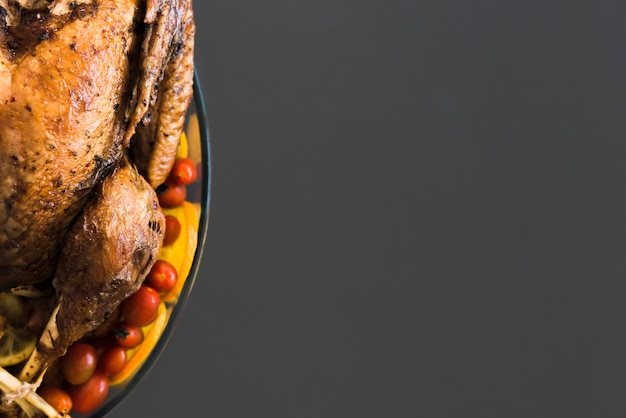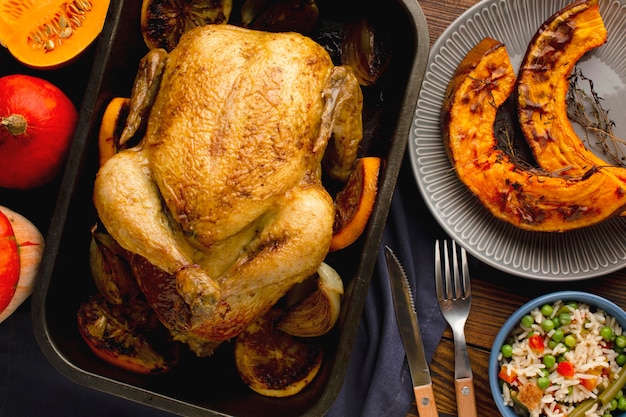Let's talk turkey, shall we? But not just any turkey, the star of the Thanksgiving table, the centerpiece of Christmas dinner: a perfectly roasted turkey, juicy and flavorful, with crispy skin that makes everyone drool. As a seasoned home cook, I've spent countless holidays perfecting my turkey roasting technique, and I'm ready to share my secrets with you.
This guide goes beyond just the right oven temperature (although that's crucial!). It delves into understanding turkey anatomy, mastering the art of prepping and basting, and navigating the nuances of cooking time, all while ensuring your bird comes out perfectly cooked and bursting with flavor. Get ready to become the master of the roast, because you're about to unlock the secrets to the juiciest, most delicious turkey you've ever tasted!
(Part 1) The Temperature Foundation

The Oven's Role in Turkey Roasting
Think of the oven temperature as the conductor of your turkey roasting orchestra. It dictates the tempo and rhythm of heat penetration, determining how quickly the bird cooks and how evenly the juices distribute.
Too low a temperature, and you're in for a long, drawn-out process, with a dry, flavorless bird as the result. Too high, and you risk burning the outside while the inside remains undercooked, creating a crispy shell hiding a disappointing core.
325°F: The Golden Standard
Through years of trial and error, I've found that 325°F (165°C) is the perfect temperature for roasting a turkey. It strikes a beautiful balance, allowing for a gradual and consistent cooking process, ensuring the meat cooks through without drying out the breast, while letting the skin get that lovely golden brown crisp. It's the sweet spot for a truly satisfying roast.
(Part 2) Knowing Your Bird

The Anatomy of a Turkey
Before we dive into the cooking process, let's take a moment to understand our culinary subject. The size and weight of your turkey play a crucial role in determining cooking time and whether you need to adjust the oven temperature. Think of it this way: a petite turkey cooks faster than its larger, more substantial cousin.
Stuffing Matters
And don't forget the stuffing! If you're stuffing your turkey, remember that it requires its own cooking time. It's a balancing act: you want the stuffing to be cooked through without overcooking the turkey, a delicate dance that requires careful timing and attention.
(Part 3) The Art of Turkey Prep

Pat, Season, and Butter: The Trifecta
Alright, let's get our hands dirty! First things first, pat your turkey dry with paper towels, both inside and out. This helps the skin crisp up beautifully. Next, season generously with your favorite herbs and spices. Salt, pepper, paprika, thyme - it's a symphony of flavor! For an extra kick, add a little butter under the skin, gently lifting it to create pockets for the butter to melt and infuse the meat with rich, savory flavor. Just remember, moderation is key to avoid a greasy turkey!
The Cooking Time Puzzle
Now, onto the crucial element: cooking time. The rule of thumb is approximately 15 minutes per pound at 325°F (165°C). However, this is just a starting point, a guide, not a set rule. The final decision relies on checking the turkey's internal temperature for doneness, as we'll discuss later.
Here's a helpful table to give you a rough idea of cooking times for various turkey sizes:
| turkey weight (lbs) | Cooking Time (hrs) |
|---|---|
| 10-12 lbs | 3-3.5 hrs |
| 12-14 lbs | 3.5-4 hrs |
| 14-16 lbs | 4-4.5 hrs |
| 16-18 lbs | 4.5-5 hrs |
Resting is Key
Once your turkey is cooked to perfection, don't rush to carve! Give it a well-deserved 30-minute rest. During this time, the juices redistribute throughout the meat, leading to a juicier, more flavorful turkey. Trust me, the wait is worth it.
(Part 4) Checking for Doneness
The Thermometer: Your Best Friend
The most reliable way to determine if your turkey is cooked through is using a meat thermometer. It's your culinary compass, guiding you to a safe and delicious outcome. The ideal internal temperature is 165°F (74°C) in the thickest part of the thigh. Ignore the pop-up timer in the turkey, it's often unreliable!
Other Doneness Clues
While the thermometer is the gold standard, here are some additional clues that your turkey might be ready:
Clear Juices: When you pierce the thickest part of the thigh with a fork, the juices should run clear, not pink.
Golden Brown Skin: The skin should be a beautiful golden brown color, indicating that it's crisped up nicely.
Loose Drumsticks: The drumsticks should move freely when you jiggle them, meaning they're cooked through and tender.
(Part 5) Basting: The Ultimate Moisture Boost
The Art of Basting
Basting your turkey is like giving it a delicious spa treatment. It's all about keeping the meat moist and flavorful, ensuring a truly succulent outcome. Use melted butter, pan drippings, or a mixture of both. Baste every 30-45 minutes during cooking, but don't overdo it – too much basting can lead to a soggy skin.
(Part 6) Amping Up the Flavor
Spice Rubs: A Flavorful Symphony
There's no limit to the flavor possibilities you can add to your turkey. I love experimenting with different spice rubs. Whether you find a recipe online or create your own masterpiece, remember to apply it evenly to all sides of the bird for a consistent taste experience.
Herbs and Garlic: Aromatic Powerhouse
Herbs and garlic are flavor game-changers. Stuff the cavity with a mix of rosemary, sage, thyme, and garlic cloves, or add them to your stuffing for an aromatic explosion. You can even infuse the basting liquid with herbs and garlic for an extra flavor boost.
Wine and Beer: A Culinary Touch
If you want to elevate your turkey to a whole new level of deliciousness, add a little wine or beer to the roasting pan. It creates a fantastic aroma and infuses the turkey with moisture, enhancing the overall flavor. Just be careful not to add too much, as it could make the turkey too salty.
(Part 7) Turkey Oven Temperature FAQs
1. Can I Cook a Turkey at a Lower Temperature?
Absolutely! You can cook a turkey at a lower temperature, such as 300°F (150°C), but it will take longer. Just remember to monitor the internal temperature closely, ensuring it reaches 165°F (74°C) for food safety.
2. Should I Cover the Turkey While It's Cooking?
Covering the turkey with foil for the first part of the cooking time can help retain moisture. However, remove the foil during the last hour of cooking to allow the skin to crisp up beautifully.
3. What if My Turkey is Too Small or Too Big?
For smaller turkeys, adjust the cooking time down accordingly. For larger turkeys, increase the cooking time and consider using a slightly higher temperature, perhaps 350°F (175°C), to ensure even cooking.
4. What if My Turkey is Frozen?
If you're using a frozen turkey, thaw it completely before cooking. Never thaw it at room temperature, as this can create a breeding ground for bacteria. The safest methods are thawing in the refrigerator for several days or in cold water for a few hours.
5. What if My Turkey is Overcooked?
It's a common turkey roasting fear, but don't fret! While you can't undo overcooking, you can salvage it by carving the meat thinly and serving it with a flavorful sauce to mask any dryness.
(Part 8) Tips for a perfect turkey
1. Choose Wisely: Fresh or Frozen?
The journey to a perfect turkey begins with choosing the right bird. Opt for a fresh or frozen turkey that has been properly stored and handled.
2. Thaw Safely and Completely
If you're using a frozen turkey, thaw it completely before cooking. Never thaw it at room temperature, as this can lead to bacterial growth. Refrigerator thawing takes several days, while cold water thawing takes a few hours.
3. Don't Overdo It: Avoid Overcooking
Overcooking is a turkey roasting nightmare! Monitor the internal temperature closely and remove the turkey from the oven as soon as it reaches 165°F (74°C).
4. The Power of Rest: Letting the Juices Settle
After cooking, let the turkey rest for at least 30 minutes before carving. This allows the juices to redistribute throughout the meat, creating a juicier, more flavorful turkey.
5. Your Culinary Compass: The Meat Thermometer
Don't rely on the pop-up timer in the turkey – it's not always accurate. Use a meat thermometer to ensure your turkey is cooked through to 165°F (74°C).
6. Experiment, Explore, Discover
There's no one "right" way to roast a turkey. Experiment with different recipes, spice rubs, and cooking techniques to find what works best for you. The culinary world is your oyster!
(Part 9) Conclusion
There you have it! The ultimate guide to roasting a turkey that will have your guests singing your praises. Remember, patience, attention to detail, and a sprinkle of culinary creativity are the key ingredients to a successful turkey roast. So, the next time you face down that festive bird, don't fear! With this knowledge in hand, you're ready to conquer the Thanksgiving table or Christmas feast. Happy roasting, and enjoy the delicious results!
Everyone is watching

Prime Rib Roast Cooking Time Chart: Per Pound Guide
Cooking TipsPrime rib roast. Just the name conjures images of lavish dinners, crackling fires, and hearty laughter. It’s ...

How Long to Bake Potatoes in the Oven (Perfect Every Time)
Cooking TipsBaked potatoes are a staple in my kitchen. They're incredibly versatile, delicious, and surprisingly easy to m...

Perfect Rice Every Time: The Ultimate Guide to Cooking Rice
Cooking TipsAs a self-proclaimed foodie, I've always been a bit obsessed with rice. It's the foundation of countless cuisi...

The Ultimate Guide to Cooking Asparagus: Tips, Techniques, and Recipes
Cooking TipsAsparagus. The mere mention of this spring delicacy conjures up images of vibrant green spears, crisp and burs...

Ultimate Guide to Cooking the Perfect Thanksgiving Turkey
Cooking TipsThanksgiving. Just the word conjures up images of overflowing tables laden with delicious food, the scent of r...
